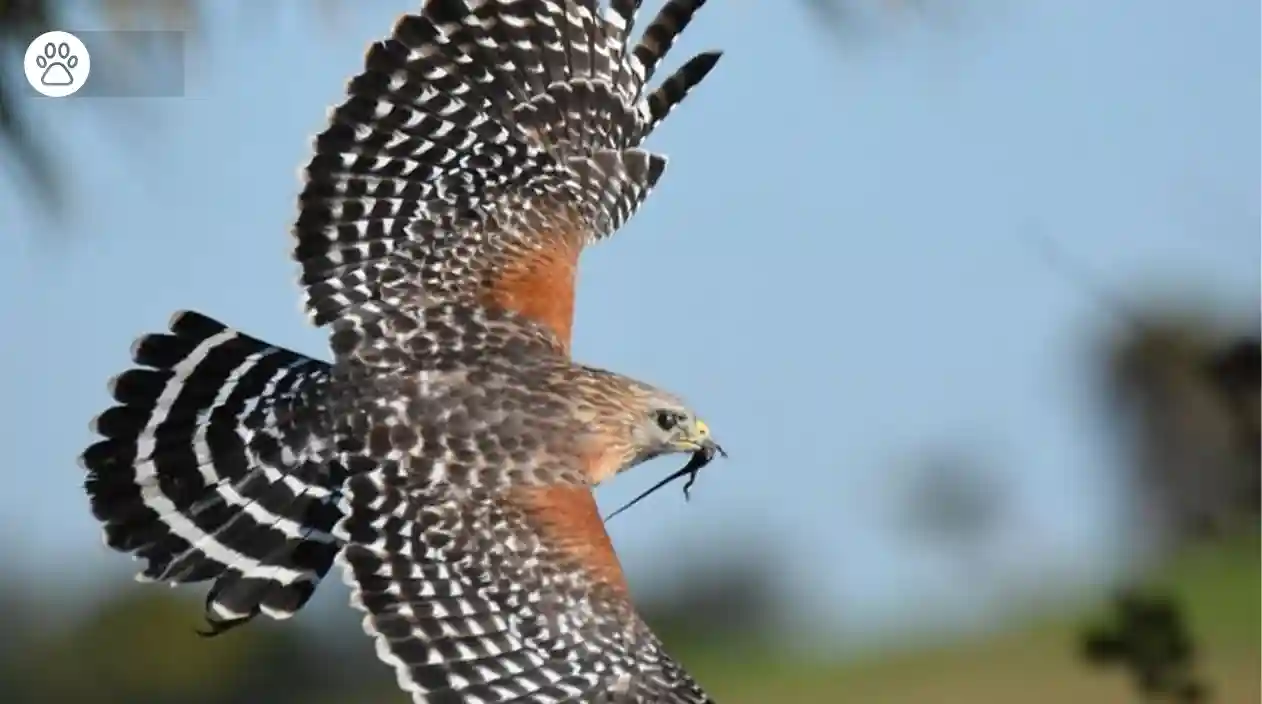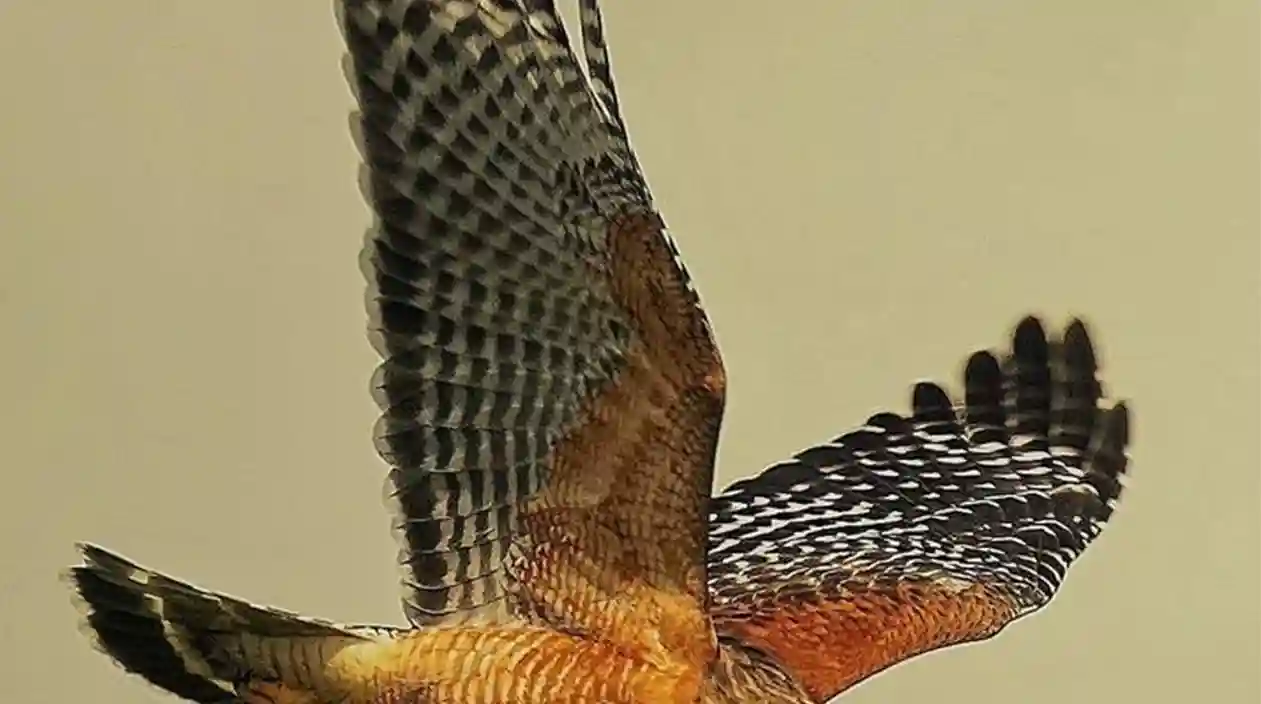“In the presence of nature, a wild delight runs through the man.” – Ralph Waldo Emerson
“Try imagining a calm, familiar place to relax, maybe a dense forest. The air is filled with the scent of pine and moist earth and the unusual beauty of nature. And, suddenly, a “whistle” interrupts the calm silence of the forest. It’s a sharp whistle!. The red shouldered hawk is a magnificent avian that glides effortlessly from the tall trees.”
What Does a Hawk Look Like?
Red-shouldered hawk (Buteo lineatus) is a medium-sized raptor bird with unique coloring and powerful flight, as noted with its social behaviors.

Visit: Red Headed Woodpecker: Habitat, Diet and Fun Facts
Key Identification Features
- Size and Shape: Measuring 16.9–24.0 inches in length and a wingspan of 37.0–43.7 inches, they have broad, rounded wings and a medium stub tail.
- Coloration: Adults have warm reddish barring on the breast and black tail with narrowing white bands and a checkered dark and white wing pattern.
- Juveniles: Young birds are without the reddish coloration of adults; rather, they are white with brown streaks under and brown on top.
- Flight pattern: When gliding, their wingtips are often set in a position to create translucent crescent shapes, exposing the wingtips.
Habitat and Range
Hawks with red shoulders can be found in North America as they prefer regions with enough cover as well as places conducive for hunting.
Preferred Habitats
- Eastern Populations: Reside in bottomland hardwood forests and upland mixed forests, flooded swamps.
- Western Populations: Live in riparian zones, oak woodlands, and even in suburban regions that have large trees.
Geographic Distribution
Their range is from Southern Canada to the eastern United States, then southwards to Florida, and from the West Coast in California, extending to Baja California.
Discover: Bombay Cat Breed: Looking More into the Mini Panther
Behavior and Nutrition
Observable behaviors in red-shouldered hawks highlight their adaptability and predation techniques.
Methods of Hunting
- Perch Hunting: Sits and scopes out the area for potential prey before descending.
- Flight Hunting: Also flies at lower altitudes in the woods and surprises woodland creatures by hiding and attacking them off guard.
Make-up of the Diet
Includes small animals such as rodents and shrews, frogs, snakes, birds, as well as large insects on rare occasions.

What Makes Red-Shouldered Hawk Features Unique? Feather Facts
Feathers do not just allow for avian movement; they tell the story of the birds’ age, lifestyle, and environment. A red shouldered hawk’s feathers tell a great deal about it.
Which Makes Their Feathers Stand Out?
- Red Shoulders: The bird is named after the rusty red feathers on the upper wing coverts, which are very clear when the bird perches or spreads its wings.
- Tail Feathers: Banding on their tail feathers is strongly differentiated, usually black with narrow white stripes. This pattern helps with identification while flying.
- Checkered Wings: A unique black and white checkered pattern is found on their upper wings. This enables them to camouflage themselves with the forest.
Explore: Pet Afterlife, Grief and Spiritual Beliefs: Do Pets Go to Heaven?
Hawk Feather Structure
- Silent Flight: This is a trait red shouldered hawks share with other raptors. They have stiff feathers with fringed edges, which lessen noise during flight. Although they do not have the ease of movement like owls do, they are able to spring without signaling.
- Molting Cycle: This takes place with adult hawks, undergoing an annual molt. Which means replacing old fringed feathers with new ones to allow for better overall performance. Juvenile red shouldered hawk’s feathers are stripped from them at the age of two.
- Feather Wear: Feather wear can provide clues regarding a hawk’s age and activity. Fresh feathers have vivid colors, whereas older ones may be dull or tattered.

Possession Legality
No one is allowed to have red-shouldered hawk feathers without a license according to the Migratory Bird Treaty Act. The intent of this law is to safeguard the species from cultural and economic exploitation. If you happen to come across a feather, enjoy it, but do not take it for your own.
“Feathers are the footprints of the skies—evidence of existence, but not something to be possessed.”
Learn More: Personality and Bonding Habits: Are Black Cats Friendly?
Breeding and Nesting
Studying the reproduction patterns of species reveals their life history and spatial dynamics.
Mating and Courtship
The majority hawks are monogamous, showing high fidelity to their nesting sites year after year. The courtship display often features soaring together, followed by some aerial diving.
Nesting Habits
These birds build their nests in broad trees next to bodies of water; they construct their nests out of twigs and add a softer material for the interior. Both parents feed and take care of the young.
Vocalizations and Communication
Their calls represent a characteristic trait that can be readily observed prior to sighting the bird.
- Primary Call: A strident, descending “kee-rah” or “kee-aah” which is repeated several times, especially in the breeding season.
- Mimicry: Blue jays mimic the call of the red-shouldered hawk, and add their voice to the chorus in the woods.
Conservation Status
Even though red-shouldered hawks don’t hold an endangered status, they are still faced with problems that may threaten their population numbers.
Check this out: Weiner Dogs: Price, Breeds, and Mini Dachshund Costs
Challenges
- Loss of Habitat: It is caused by wetlands being drained and forests being cleared, which reduces space available for nesting and hunting.
- Human Activities: Urban sprawl causes fragmentation of habitats and alters the landscape of traditional ranges.
Conservation Actions
The Audubon Society and HawkWatch International actively monitor population changes and advocate for the protection of these birds’ habitats.
Conclusion
A red shouldered hawk is more than just a bird of prey; it showcases the beauty of balanced nature. This unique creature Red-shouldered hawk, is even more powerful than their name suggests. Their calls, striking feathers, eye-catching coloration, and vibrant colors ensure they are never overlooked. Learning about their ecological interdependence through behavior, habitat, and their movement patterns adds to the need to protect ecological balance.
Whether you’re an avid birdwatcher or a casual nature enthusiast, the sight of this hawk is something that cannot be looked past, being quite memorable. All attention should be directed to the conservation of their habitats to maintain usability of their environment for future generations. Always remember to stay vigilant because the red shoulder hawk’s stunning grace is bound to leave you stunned.
